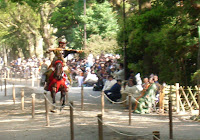 April 19, 2009
April 19, 2009 Kamakura: home to Japan’s first samurai regime
Kamakura, about an hour of train ride from Tokyo, was home to the first regime established by samurai warriors in the late 12th century. Kamakura is currently one of the busiest tourist spots in Japan. Tsurugaoka Hachimangu Shrine, the symbol of Kamakura which stands in the heart of the city, was inaugurated by Minamoto Yoritomo (1147-1199), the first shogun of the Kamakura shogunate.
Yoritomo came to power after 20 years of exile and opened his regime in Kamakura, a domain for his father and grandfather.
Kamakura holds city-wide spring and autumn festivals, including rites devoted to the God of Hachiman, a war-related god, to which Tsurugaoka Shrine is dedicated. The “yabusame” arrow-shooting rite is one of the most attractive events in the festivals.
Dating back to the era of the Kamakura shogunate, the original yabusame rite was performed in the presence of Yoritomo.
A waka poem composed by Yoritomo and included in the Shinkokinwakashu poem anthology of the early 13th century says:
On my way to this place via a path near the foot of Mt. Fuji,
I did not observe any smoke up there,
because the sky had been covered by thick clouds all the time.
(A personal translation)
A recently compiled book discusses a collection of Kamakura-related poems, including one made by the Kamakura shogun. “I found Yoritomo had left many nice poems, and this was a surprise to me,” says a noted essayist who wrote the book. Yoritomo is believed to have composed the poem about the then active volcano impromptu when asked by a friend of his upon his arrival at Kyoto.
On my way to this place via a path near the foot of Mt. Fuji,
I did not observe any smoke up there,
because the sky had been covered by thick clouds all the time.
(A personal translation)
A recently compiled book discusses a collection of Kamakura-related poems, including one made by the Kamakura shogun. “I found Yoritomo had left many nice poems, and this was a surprise to me,” says a noted essayist who wrote the book. Yoritomo is believed to have composed the poem about the then active volcano impromptu when asked by a friend of his upon his arrival at Kyoto.
Warlords at his time were busy reinforcing their clans, but they also tried hard to be good poets in rivalry with court nobles of the old regime in Kyoto.
Yoritomo is less popular among Japanese because he is regarded as a cold-hearted realist, but some critics stress that his statesmanship and insight must be reevaluated properly. A state leader like Yoritomo may be necessary for today’s Japan now that the economy is floating in unchartered waters.
An author’s note: Most “busho” ancient warlords, including the first Kamakura shogun, are referred to by their given names to avoid confusion because they belong mainly to two surname groups—Minamoto and Taira.
An author’s note: Most “busho” ancient warlords, including the first Kamakura shogun, are referred to by their given names to avoid confusion because they belong mainly to two surname groups—Minamoto and Taira.
No comments:
Post a Comment